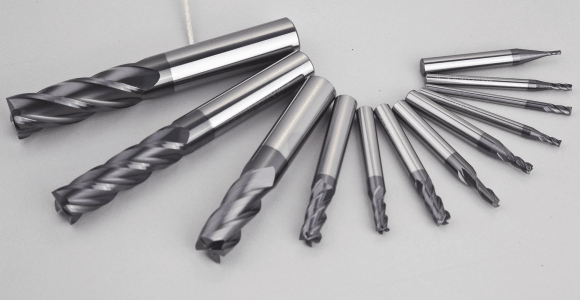Causes and Countermeasures of NC tool edge collapse
1) improper selection of blade brand and standard, such as too thin blade thickness or too hard and brittle trademark during rough machining.
Countermeasures: increase the blade thickness or install the blade vertically, and select the trademark with high bending strength and resistance.
2) improper selection of several parameters of the tool (such as too large front and rear angle, etc.).
Countermeasures: we can start from the following aspects to plan the tool from scratch. ① Reduce the front and rear angles properly. ② Select a larger negative inclination angle. ③ Reduce the main deflection angle. ④ Select larger negative chamfering or edge arc. ⑤ Sharpen the transition cutting edge to enhance the tool tip.
3) the welding process of the blade is not correct, resulting in excessive welding stress or welding cracks.
Countermeasures: ① prevent the use of three closed blade slot structure. ② Choose solder correctly. ③ It should be avoided to choose oxyacetylene flame for heating welding, and should be kept warm after welding to eliminate internal stress. ④ Mechanical clamping structure shall be used as far as possible
4) improper grinding method results in grinding stress and grinding crack; excessive vibration and swing of cutter teeth after grinding PCBN milling cutter edge will lead to excessive load of single cutter tooth, which will also form a cutter.
Countermeasures: ① choose intermittent grinding or diamond grinding wheel grinding. ② Choose soft grinding wheel, and often dressing, adhere to the sharp grinding wheel. ③ Pay attention to the grinding quality and strictly control the vibration and swing of milling cutter teeth.
5) the selection of cutting parameters is unreasonable, such as too much, the machine tool will be closed; in intermittent cutting, the cutting speed is too high, the feed is too large, and when the blank allowance is uneven, the cutting depth is too small; when cutting high manganese steel and other data with large work hardening tendency, the feed rate is too small.
Countermeasures: select cutting parameters from scratch.

6) there are structural reasons such as the bottom surface of the tool groove is not flat or the blade is too long.
Countermeasures: ① trim the bottom of the tool groove. ② Position the cutting fluid nozzle reasonably. ③ Cemented carbide gasket is added under the blade of hardened cutter bar.
7) excessive tool wear.
Countermeasures: change the tool or replace the cutting edge in time.
8) the cutting fluid flow is insufficient or the filling method is incorrect, resulting in the blade cracking due to sudden heat.
Countermeasures: ① increase the flow rate of cutting fluid. ② Position the cutting fluid nozzle reasonably. 3. Choose effective cooling methods such as spray cooling to improve the cooling effect. ④ Select * cutting to reduce the impact on the blade.
9) the cutter device is not correct, such as too high or too low of the blocking turning tool device; the end milling cutter adopts asymmetric forward milling, etc.
Countermeasure: install the tool from the beginning.
10) the rigidity of the process system is too poor, resulting in excessive cutting vibration.
Countermeasures: ① increase the auxiliary support of the workpiece and improve the clamping rigidity of the workpiece. ② Reduce the tool overhanging length. ③ Reduce the tool back angle properly. ④ Other vibration elimination methods are selected.
11) careless operation, for example: the tool moves too hard when cutting from the workpiece; parking is performed when the tool is not withdrawn.
Countermeasures: pay attention to the operation method.
Source: Zhongshan tungsten steel milling cutterhttp://www.gdsgdj.com
-
10-12
What are the causes of chip accretion on NC tools?
The reason is that the chip bottom metal is embedded in the micro uneven peak valley on the front cutter surface due to the large down pressure in the part close to the cutting edge, forming a gap free metal to metal touch, which is called the bonding area. In the bonding zone, there will be a thin layer of metal data accumulated on the rake face at the bottom of the chip. The metal data of this part of the chip is severely deformed and strengthened at the appropriate cutting temperature. With t
-
10-12
What are the wear types of tungsten steel milling cutters?
Abrasive wear machining materials often have some very hard particles, these particles will form grooves on the surface of the tool, which is the grinding loss. All surfaces are worn, especially the rake face. In addition, although the wear of hemp occurs at various cutting speeds, the wear caused by other reasons is not obvious due to the low cutting temperature at low cutting speed, so it is mainly the abrasion of abrasive materials. The lower the tool hardness is, the more serious the grindin